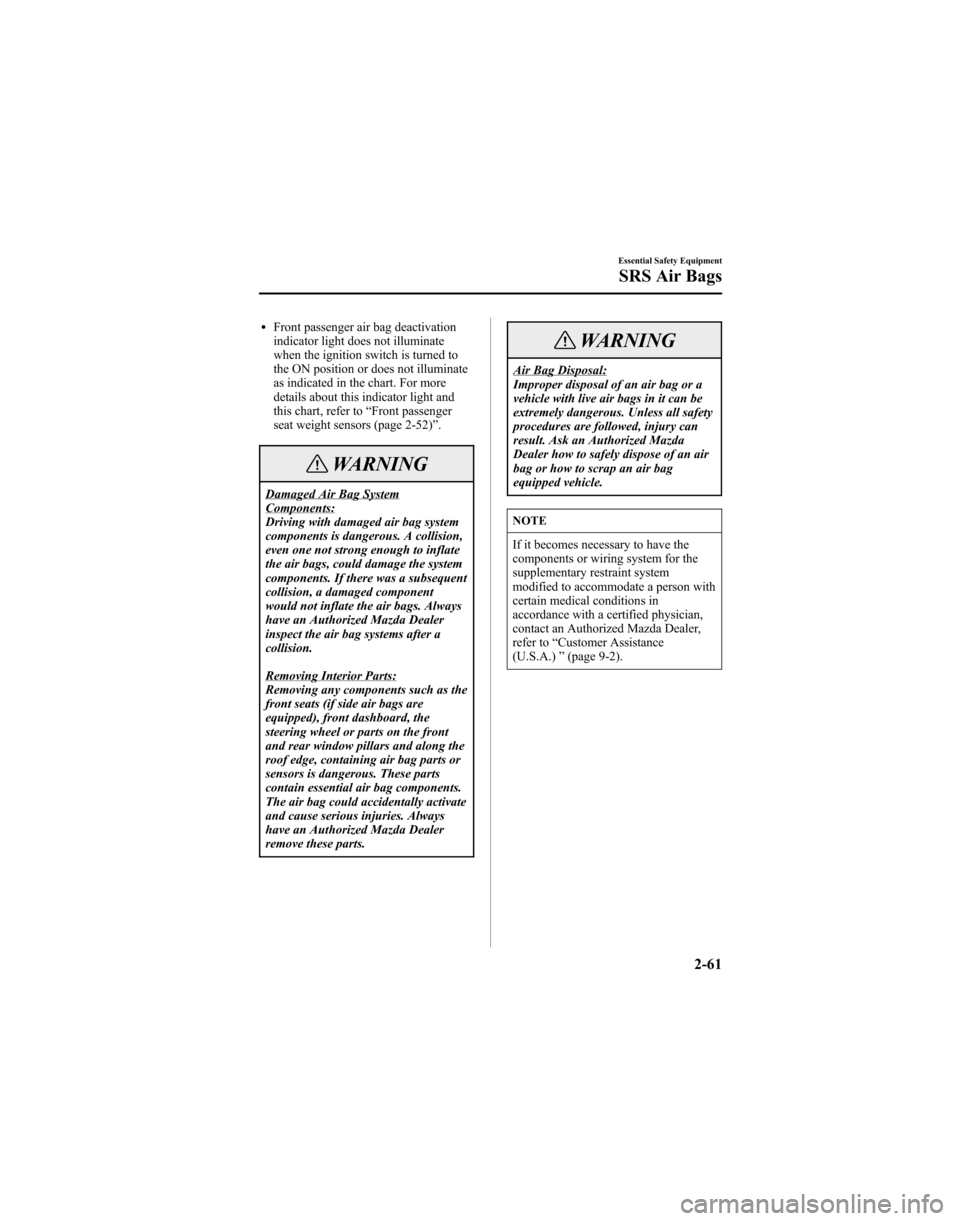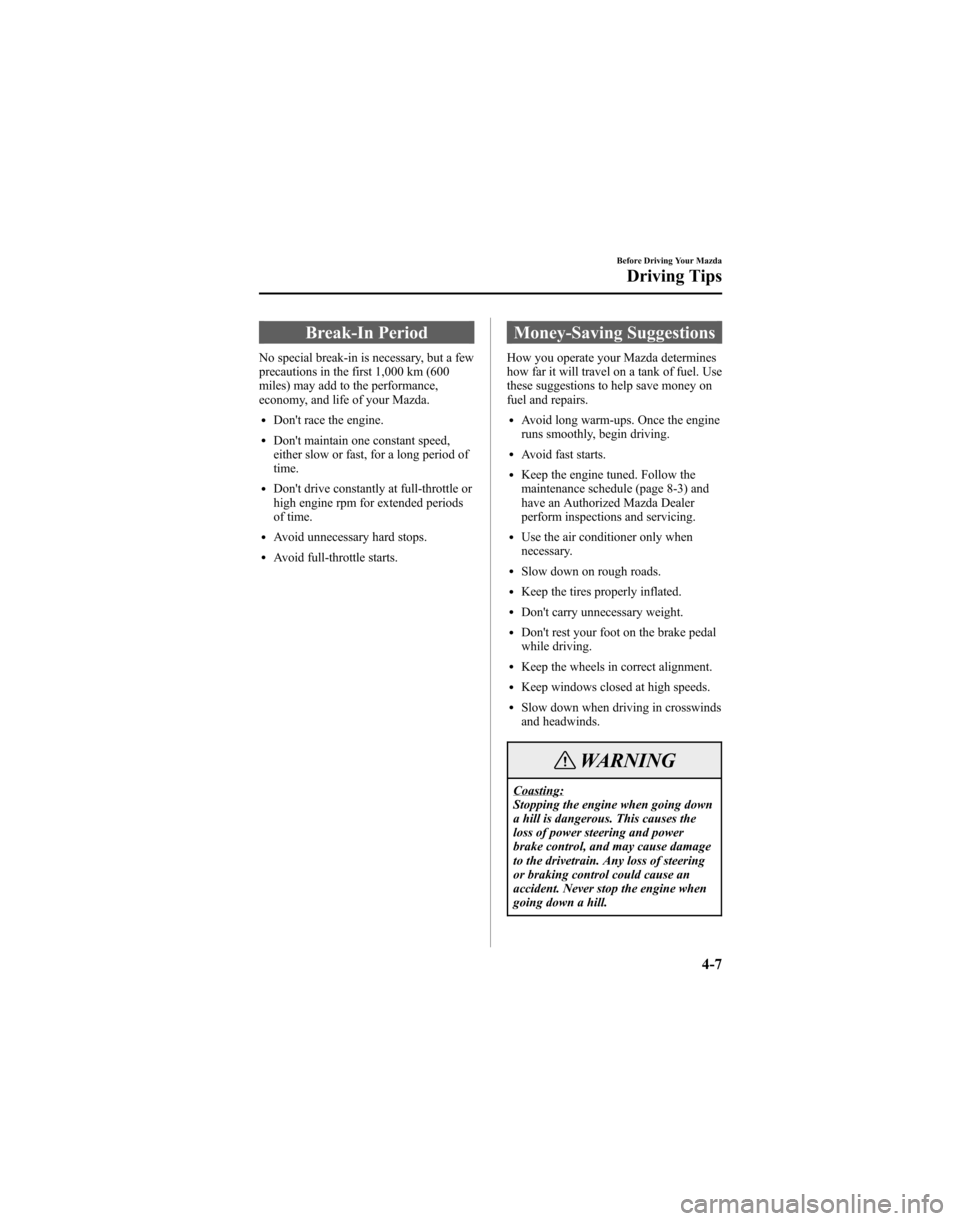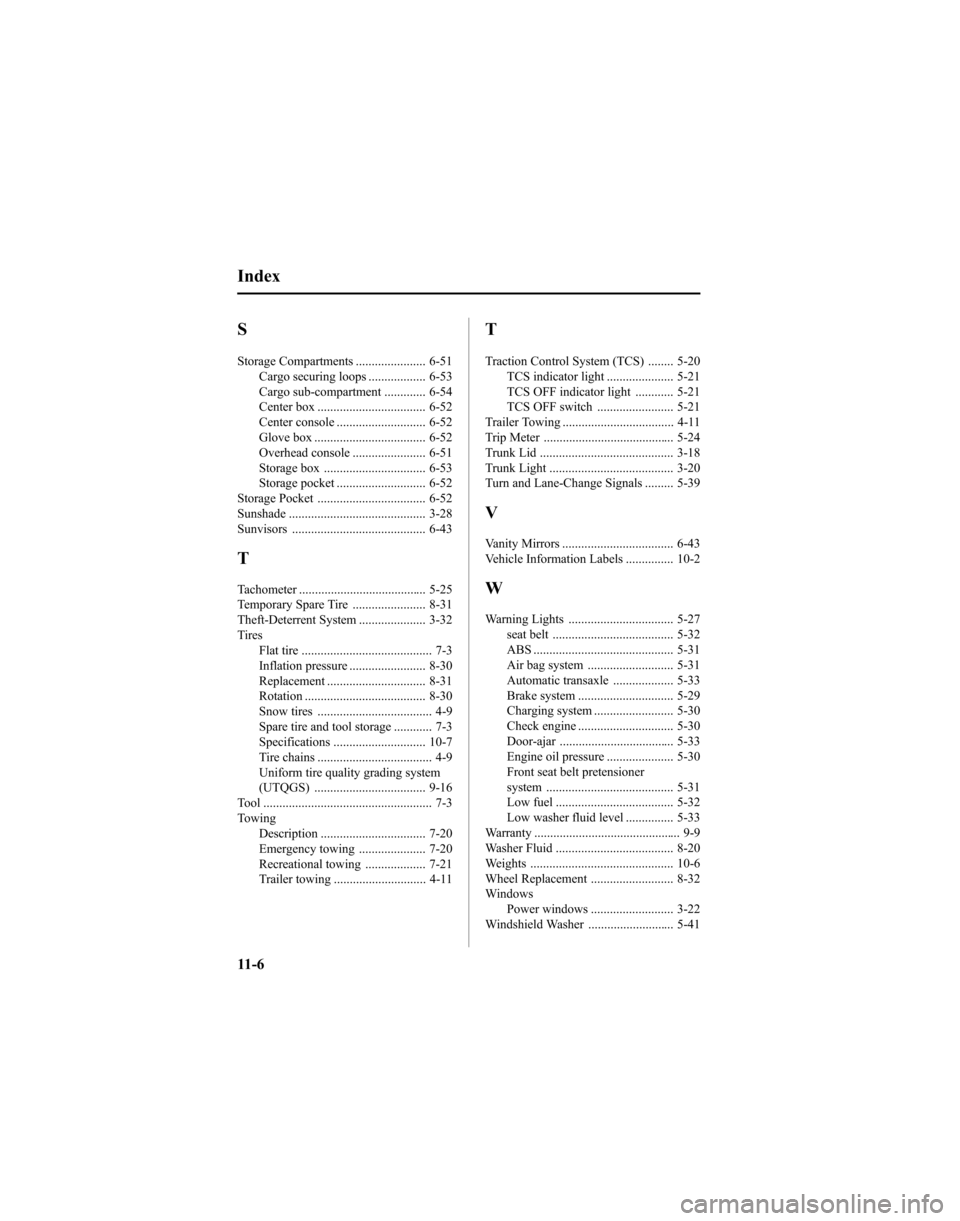weight MAZDA MODEL 6 HATCHBACK 2005 (in English) User Guide
[x] Cancel search | Manufacturer: MAZDA, Model Year: 2005, Model line: MODEL 6 HATCHBACK, Model: MAZDA MODEL 6 HATCHBACK 2005Pages: 340, PDF Size: 3.08 MB
Page 74 of 340

qConstant Monitoring
The following components of the air bag
systems are monitored by a diagnostic
system:
lSAS unit
lFront air bag sensor
lAir bag modules
lSide crash sensorí
lFront seat belt pretensioners
lRelated wiring
lDriver seat slide position sensor
lFront passenger seat weight sensors
lDriver and front passenger seat belt
buckle switches
The diagnostic module continuously
monitors the system's readiness. This
begins when the ignition switch is turned
to the ON position and continues while
the vehicle is being driven.
q Air Bag/Front Seat Belt
Pretensioner System Warning
Light
If the air bag/front seat belt pretensioner
system is normal, the warning light
illuminates when the ignition switch is
turned to the ON position or after the
engine is cranked. After about 6 seconds
it goes out. A system malfunction is indicated when
the warning light constantly flashes,
illuminates or doesn't illuminate at all
when the ignition switch is turned to the
ON position. If any of these occur, consult
an Authorized Mazda Dealer as soon as
possible. The system may not work in an
accident.
WARNING
Self-Servicing the Air Bag/Pretensioner Systems:
Self-servicing or tampering with the
systems is dangerous. An air bag/
pretensioner could accidentally
activate or become disabled. This
could cause serious injuries. Never
tamper with the systems and always
have an Authorized Mazda Dealer
perform all servicing and repairs.
q
Maintenance
The air bag systems do not require regular
maintenance. But if any of the following
occurs, take your vehicle to an Authorized
Mazda Dealer as soon as possible:
lThe air bag system warning light
flashes.
lThe air bag system warning light
remains illuminated.
lThe air bag system warning light does
not illuminate when the ignition switch
is turned to the ON position.
lThe air bags inflate.
2-60
Essential Safety Equipment
íSome models.
SRS Air Bags
Page 75 of 340

lFront passenger air bag deactivation
indicator light does not illuminate
when the ignition switch is turned to
the ON position or does not illuminate
as indicated in the chart. For more
details about this indicator light and
this chart, refer to“Front passenger
seat weight sensors (page 2-52) ”.
WARNING
Damaged Air Bag SystemComponents:
Driving with damaged air bag system
components is dangerous. A collision,
even one not strong enough to inflate
the air bags, could damage the system
components. If there was a subsequent
collision, a damaged component
would not inflate the air bags. Always
have an Authorized Mazda Dealer
inspect the air bag systems after a
collision.
Removing Interior Parts:
Removing any components such as the
front seats (if side air bags are
equipped), front dashboard, the
steering wheel or parts on the front
and rear window pillars and along the
roof edge, containing air bag parts or
sensors is dangerous. These parts
contain essential air bag components.
The air bag could accidentally activate
and cause serious injuries. Always
have an Authorized Mazda Dealer
remove these parts.
WARNING
Air Bag Disposal:
Improper disposal of an air bag or a
vehicle with live air bags in it can be
extremely dangerous. Unless all safety
procedures are followed, injury can
result. Ask an Authorized Mazda
Dealer how to safely dispose of an air
bag or how to scrap an air bag
equipped vehicle.
NOTE
If it becomes necessary to have the
components or wiring system for the
supplementary restraint system
modified to accommodate a person with
certain medical conditions in
accordance with a certified physician,
contact an Authorized Mazda Dealer,
refer to “Customer Assistance
(U.S.A.) ”(page 9-2).
Essential Safety Equipment
SRS Air Bags
2-61
Page 119 of 340

Break-In Period
No special break-in is necessary, but a few
precautions in the first 1,000 km (600
miles) may add to the performance,
economy, and life of your Mazda.
lDon't race the engine.
lDon't maintain one constant speed,
either slow or fast, for a long period of
time.
lDon't drive constantly at full-throttle or
high engine rpm for extended periods
of time.
lAvoid unnecessary hard stops.
lAvoid full-throttle starts.
Money-Saving Suggestions
How you operate your Mazda determines
how far it will travel on a tank of fuel. Use
these suggestions to help save money on
fuel and repairs.
lAvoid long warm-ups. Once the engine
runs smoothly, begin driving.
lAvoid fast starts.
lKeep the engine tuned. Follow the
maintenance schedule (page 8-3) and
have an Authorized Mazda Dealer
perform inspections and servicing.
lUse the air conditioner only when
necessary.
lSlow down on rough roads.
lKeep the tires properly inflated.
lDon't carry unnecessary weight.
lDon't rest your foot on the brake pedal
while driving.
lKeep the wheels in correct alignment.
lKeep windows closed at high speeds.
lSlow down when driving in crosswinds
and headwinds.
WARNING
Coasting:
Stopping the engine when going down
a hill is dangerous. This causes the
loss of power steering and power
brake control, and may cause damage
to the drivetrain. Any loss of steering
or braking control could cause an
accident. Never stop the engine when
going down a hill.
Before Driving Your Mazda
Driving Tips
4-7
Page 122 of 340

Driving In Flooded Area
WARNING
Driving with Wet Brakes:
Driving with wet brakes is dangerous.
Increased stopping distance or the
vehicle pulling to one side when
braking could result in a serious
accident. Light braking will indicate
whether the brakes have been affected.
Dry the brakes by driving very slowly
and applying the brakes lightly until
brake performance returns to normal.
CAUTION
Make sure water does not enter the
vehicle interior or the engine area. The
vehicle interior could become wet or
the engine could be damaged.
Overloading
WARNING
Vehicle Load Weight:
The gross axle weight rating (GAWR)
and the gross vehicle weight rating
(GVWR) of your vehicle are on the
Motor Vehicle Safety Standard Label
on the driver's door frame. Exceeding
these ratings can cause an accident or
vehicle damage. You can estimate the
weight of your load by weighing the
items (or people) before putting them
in the vehicle. Be careful not to
overload your vehicle.
4-10
Before Driving Your Mazda
Driving Tips
Page 139 of 340

If the vehicle is kicked down at the following speeds
or lower, the gears shift down automatically:Gear Vehicle speed
M6 →M5 212 km/h (131 mph)
M6 →M4 161 km/h (100 mph)
M5 →M4 161 km/h (100 mph)
M5 →M3 70 km/h (44 mph)
M4 →M3 70 km/h (44 mph)
M4 →M2 46 km/h (28 mph)
M3 →M2 46 km/h (28 mph)
Recommendations for shifting
Upshifting
For normal acceleration and cruising, we recommend
these shift points.
(2.3-liter engine)
Gear Vehicle speed
M1 to M2 24 km/h (15 mph)
M2 to M3 40 km/h (25 mph)
M3 to M4 65 km/h (40 mph)
(3.0-liter engine)
Gear Vehicle speed
M1 to M2 24 km/h (15 mph)
M2 to M3 40 km/h (25 mph)
M3 to M4 65 km/h (40 mph)
M4 to M5 73 km/h (45 mph)
M5 to M6 80 km/h (50 mph)
Downshifting
When you must slow down in heavy
traffic or on a steep upgrade, downshift
before the engine starts to overwork. This
gives better acceleration when you need
more speed.
On a steep downgrade , downshifting
helps maintain safe speed and prolongs
brake life.
q Driving Tips
Passing
For extra power when passing another
vehicle or climbing steep grades, depress
the accelerator fully. The transaxle will
shift to a lower gear, depending on vehicle
speed.
Climbing steep grades from a stop
To climb a steep grade from a stopped
position:
1. Depress the brake pedal.
2. Shift to D or M1, depending on the
load weight and grade steepness.
3. Release all brakes while gradually accelerating.
Descending steep grades
When descending a steep grade, shift to
lower gears, depending on load weight
and grade steepness. Descend slowly,
using the brakes only occasionally to
prevent them from overheating.
Driving Your Mazda
Starting and Driving
5-15
Page 279 of 340

qBattery Maintenance
To get the best service from a battery:
lKeep it securely mounted.
lKeep the top clean and dry.
lKeep terminals and connections clean,
tight, and coated with petroleum jelly
or terminal grease.
lRinse off spilled electrolyte
immediately with a solution of water
and baking soda.
lIf the vehicle will not be used for an
extended time, disconnect the battery
cables and charge the battery every six
weeks.
Tires
For reasons of proper performance, safety,
and better fuel economy, always maintain
recommended tire inflation pressures and
stay within the recommended load limits
and weight distribution.
WARNING
Using Different Tire Types:
Driving your vehicle with different
types of tires is dangerous. It could
cause poor handling and poor
braking; leading to loss of control.
Except for the limited use of the
temporary spare tire, use only the
same type tires (radial, bias-belted,
bias-type) on all four wheels.
Using Wrong-Sized Tires:
Using any other tire size than what is
specified for your Mazda (page 10-7)
is dangerous. It could seriously affect
ride, handling, ground clearance, tire
clearance, and speedometer
calibration. This could cause you to
have an accident. Use only tires that
are the correct size specified for your
Mazda.
Maintenance and Care
Owner Maintenance
8-29
Page 330 of 340

qWeights
Item Weight
GVWR (Gross Vehicle Weight Rating) Sedan 1,956 kg (4,312 lb)
5-Door/Sport Wagon 2,037 kg (4,491 lb)
GAWR (Gross Axle Weight Rating) Sedan
Front 1,071 kg (2,361 lb)
Rear 888 kg (1,958 lb)
5-Door/Sport Wagon Front 1,076 kg (2,372 lb)
Rear 961 kg (2,119 lb)
q
Air Conditioner
Gas complies with SAE J639 Maximum operating charge
HFC134a (R-134a) 0.5 kg (17.6 oz)
q Light Bulbs
Exterior light
Light bulb Category
Wattage ECE R SAE
Headlights High beam 55 H1
―
Low beam 55 H1 ―
Front turn signal lights 28
*1― #2357A
Parking lights 5 W5W ―
Fog lights
í55 H3 ―
Side-marker lights 5 W5W ―
High-mount brake light Sedan/Sport Wagon 18.4 W16W #921
5-Door 21
――
Rear turn signal lights 21 WY21W ―
Brake lights/Taillights 21/5 W21/5W #7443
Taillights 5
*2W21/5W #7443
Reverse lights 18.4 W16W #921
License plate lights 5 W5W ―
*1 Use a 28/7W type bulb.
*2 Use a 21/5W type bulb.
10-6íSome models.
Specifications
Page 338 of 340

S
Storage Compartments ...................... 6-51Cargo securing loops .................. 6-53
Cargo sub-compartment ............. 6-54
Center box .................................. 6-52
Center console ............................ 6-52
Glove box ................................... 6-52
Overhead console ....................... 6-51
Storage box ................................ 6-53
Storage pocket ............................ 6-52
Storage Pocket .................................. 6-52
Sunshade ........................................... 3-28
Sunvisors .......................................... 6-43
T
Tachometer ........................................ 5-25
Temporary Spare Tire ....................... 8-31
Theft-Deterrent System ..................... 3-32
Tires
Flat tire ......................................... 7-3
Inflation pressure ........................ 8-30
Replacement ............................... 8-31
Rotation ...................................... 8-30
Snow tires .................................... 4-9
Spare tire and tool storage ............ 7-3
Specifications ............................. 10-7
Tire chains .................................... 4-9
Uniform tire quality grading system
(UTQGS) ................................... 9-16
Tool ..................................................... 7-3
Towing Description ................................. 7-20
Emergency towing ..................... 7-20
Recreational towing ................... 7-21
Trailer towing ............................. 4-11
T
Traction Control System (TCS) ........ 5-20
TCS indicator light ..................... 5-21
TCS OFF indicator light ............ 5-21
TCS OFF switch ........................ 5-21
Trailer Towing ................................... 4-11
Trip Meter ......................................... 5-24
Trunk Lid .......................................... 3-18
Trunk Light ....................................... 3-20
Turn and Lane-Change Signals ......... 5-39
V
Vanity Mirrors ................................... 6-43
Vehicle Information Labels ............... 10-2
W
Warning Lights ................................. 5-27 seat belt ...................................... 5-32
ABS ............................................ 5-31
Air bag system ........................... 5-31
Automatic transaxle ................... 5-33
Brake system .............................. 5-29
Charging system ......................... 5-30
Check engine .............................. 5-30
Door-ajar .................................... 5-33
Engine oil pressure ..................... 5-30
Front seat belt pretensioner
system ........................................ 5-31
Low fuel ..................................... 5-32
Low washer fluid level ............... 5-33
Warranty .............................................. 9-9
Washer Fluid ..................................... 8-20
Weights ............................................. 10-6
Wheel Replacement .......................... 8-32
Windows
Power windows .......................... 3-22
Windshield Washer ........................... 5-41
11-6
Index